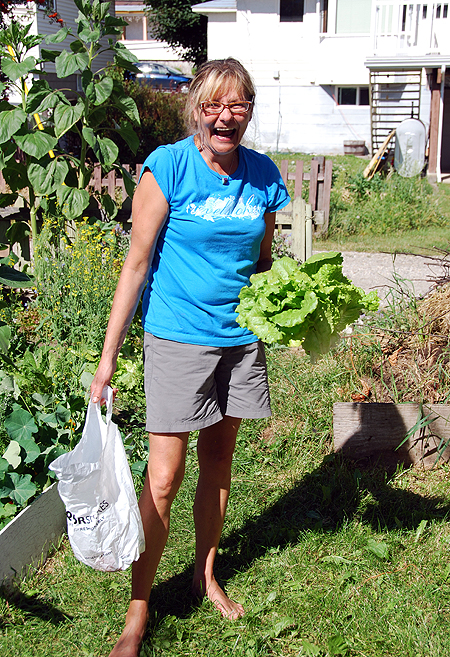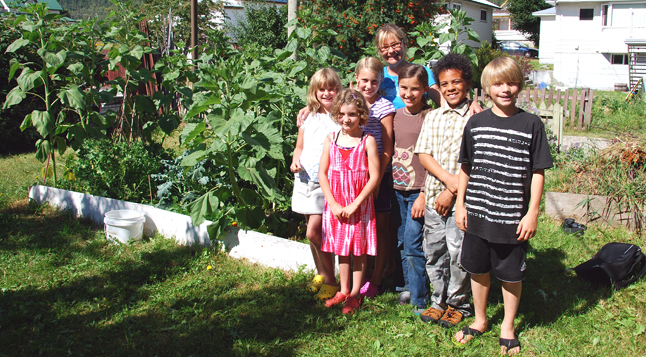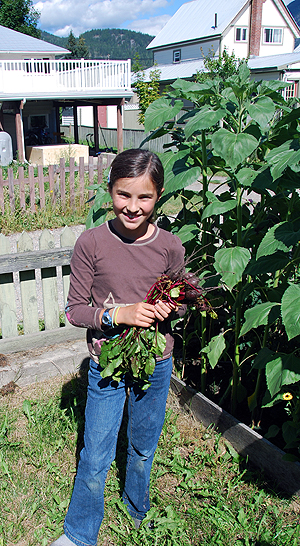
“The world is changing, and I think human beings are in a position where we are going to need to grow our own food, not because we can’t rely on grocery stores, but because the nutritional values of industrially-farmed food are diminishing. One way to restore value to food is to grow it yourself.”
This is Sandra Davis’s rationale for a proposal she’s writing to the School Board to suggest that the new elementary school include a plan for a children’s community garden.
As a prototype, Sandra has worked this summer in the Ikinetti’s back yard with eight kids each of whom has about a square metre of their own in which to grow whatever they want. Sandra and a group of parents oversee the group, who are growing everything from beets to marigolds, in patterns from straight lines to waves and a happy face of lettuces.

“I thought when we started that the children would lose interest over the summer. That hasn’t happened. One day I went over, and one boy was curled up in his plot, head right down at leaf level.
“What’s up?” I asked.
“Oh, I’m just watching my carrots grow,” he said.
Josie Koerber, Elizabeth Elliott, Jaclyn Elliott, Arden Davis, Tettey Tetteh, Shey Townley, and Andreas and Chloe Souchovs have been planting, weeding, harvesting and trading their produce all summer long, and their gardens are lush and plentiful.
Sandra has lots of experience. In Brackendale, where she lived for twelve years, she had a herb garden with over 600 varieties of herbs and plants, many of them from heritage rootstock or seeds. When she and her family moved to Revelstoke in 2006, she immediately turned her front yard into a garden, and as well as the children’s garden has access to another unused plot on 4th, growing corn, cucumbers, pumpkins and potatoes with the kids — things there was no room for in their smaller allotments.
The benefits of a children’s school garden include a list of lessons in botany and biology: what seeds are about, where they come from, the purpose of a seed, how important roots are, what is the role of fruit and or vegetables in a plant, how to space seeds, what a weed is and isn’t, how and when to harvest, and not least—the delights of eating carrots or lettuce fresh from the garden.

Social aspects of a collective garden include observation and sharing skills for children. Sandra and the other parents anticipated harvesting issues—things would ripen at different times, and they wondered if this would generate issues among the kids. What’s happened is that the kids worked them out by sharing their own produce — “Look I’ve got too many beets, can I trade you for some carrots?”

A children’s garden would follow an emerging trend, one we see in Revelstoke as well as across the world: the return of the family garden. In cities, people are using rooftops to garden as well as backyards. Allotments are back with a vengeance — not just at Revelstoke’s United Church, but in parking lots and vacant lots across the continent. A school in Nakusp has done a children’s garden. Our friends Peter and Jayne (see photo) in Woking, England, have not one but three allotments, one of which they use as a flower garden and terrace, with table and garden chairs for lunch while they work in the other two. Their gardens are pretty much a full time job—they’re both retired—and provide veg and fruit (strawberries, raspberries, gooseberries, soon plums) for themselves and a host of friends and family.
Many Revelstoke families — particularly but not only those of Italian background — have had backyard gardens for years. The Current is planning to help honour our gardeners with some Harvest Festival activities coming later in the season. Also, we’re going to bring Sandra on board to write an occasional column about gardens, harvests and how to benefit from the glut of some veggies that inevitably occurs when your garden grows well.
Meanwhile, we welcome your comments about a community school garden for children as part of the science curriculum.
In the meanwhile, here are some additional images of these kids with green thumbs:








